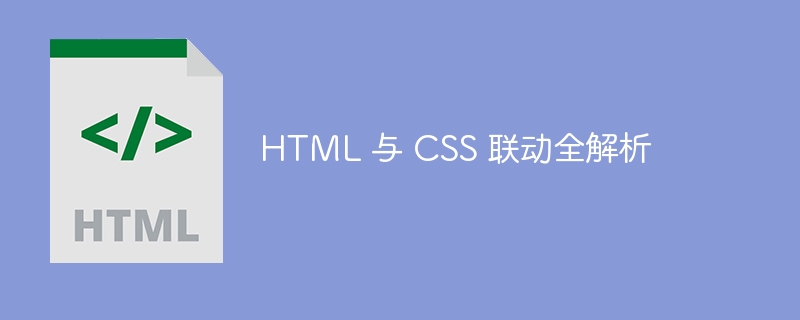Full analysis of HTML and CSS linkage
HTML and CSS linkage can create interactive and user-friendly web pages by using HTML to define the page structure, and then using CSS for styling and layout. The linkage steps are as follows: Use the <link> tag to link the CSS to the HTML document. Use selectors to select specific HTML elements in CSS. Apply style properties to set text, colors, borders, and more.

Full analysis of HTML and CSS linkage
Introduction:
HTML and CSS They are two essential technologies in web development. HTML defines the structure of the page, while CSS is responsible for styling and layout. Linking these two technologies can create interactive and user-friendly Web pages.
HTML Basics:
HTML uses tags to define different types of elements, such as headings, paragraphs, and lists. These tags are interpreted by the browser to render the page on the screen. For example:
<h1>这是标题</h1> <p>这是一段文本</p> <ul> <li>列表项 1</li> <li>列表项 2</li> </ul>
CSS Basics:
CSS uses selectors to select specific elements and apply styles. Styles can include attributes such as color, font, and border. For example:
h1 {
color: red;
}
p {
font-size: 12px;
}HTML and CSS linkage:
To link HTML and CSS, you can use the <link> tag, as shown below:
<head> <link rel="stylesheet" href="style.css"> </head>
This will load an external CSS file named style.css.
Practical case:
Let’s create a simple web form to collect user input.
<h1>用户注册</h1> <form> <label for="name">姓名:</label> <input type="text" name="name"> <br> <label for="email">邮箱:</label> <input type="email" name="email"> <br> <input type="submit"> </form>
form {
background-color: #f0f0f0;
}
label {
display: block;
margin-bottom: 5px;
}
input[type="text"] {
width: 100%;
padding: 5px;
border: 1px solid #ccc;
}
input[type="email"] {
width: 100%;
padding: 5px;
border: 1px solid #ccc;
}
input[type="submit"] {
background-color: #008000;
color: white;
padding: 5px 10px;
border: none;
}In our HTML code, we define a form with two input fields (name and email) and a submit button. In our CSS code, we applied styles to provide the background color of the form, the text alignment of the labels, and the borders of the input fields.
Running this code will create a user registration form in the browser, styled according to our CSS requirements.
The above is the detailed content of Full analysis of HTML and CSS linkage. For more information, please follow other related articles on the PHP Chinese website!

Hot AI Tools

Undresser.AI Undress
AI-powered app for creating realistic nude photos

AI Clothes Remover
Online AI tool for removing clothes from photos.

Undress AI Tool
Undress images for free

Clothoff.io
AI clothes remover

Video Face Swap
Swap faces in any video effortlessly with our completely free AI face swap tool!

Hot Article

Hot Tools

Notepad++7.3.1
Easy-to-use and free code editor

SublimeText3 Chinese version
Chinese version, very easy to use

Zend Studio 13.0.1
Powerful PHP integrated development environment

Dreamweaver CS6
Visual web development tools

SublimeText3 Mac version
God-level code editing software (SublimeText3)

Hot Topics
 How to use bootstrap in vue
Apr 07, 2025 pm 11:33 PM
How to use bootstrap in vue
Apr 07, 2025 pm 11:33 PM
Using Bootstrap in Vue.js is divided into five steps: Install Bootstrap. Import Bootstrap in main.js. Use the Bootstrap component directly in the template. Optional: Custom style. Optional: Use plug-ins.
 The Roles of HTML, CSS, and JavaScript: Core Responsibilities
Apr 08, 2025 pm 07:05 PM
The Roles of HTML, CSS, and JavaScript: Core Responsibilities
Apr 08, 2025 pm 07:05 PM
HTML defines the web structure, CSS is responsible for style and layout, and JavaScript gives dynamic interaction. The three perform their duties in web development and jointly build a colorful website.
 React's Role in HTML: Enhancing User Experience
Apr 09, 2025 am 12:11 AM
React's Role in HTML: Enhancing User Experience
Apr 09, 2025 am 12:11 AM
React combines JSX and HTML to improve user experience. 1) JSX embeds HTML to make development more intuitive. 2) The virtual DOM mechanism optimizes performance and reduces DOM operations. 3) Component-based management UI to improve maintainability. 4) State management and event processing enhance interactivity.
 Understanding HTML, CSS, and JavaScript: A Beginner's Guide
Apr 12, 2025 am 12:02 AM
Understanding HTML, CSS, and JavaScript: A Beginner's Guide
Apr 12, 2025 am 12:02 AM
WebdevelopmentreliesonHTML,CSS,andJavaScript:1)HTMLstructurescontent,2)CSSstylesit,and3)JavaScriptaddsinteractivity,formingthebasisofmodernwebexperiences.
 How to set up the framework for bootstrap
Apr 07, 2025 pm 03:27 PM
How to set up the framework for bootstrap
Apr 07, 2025 pm 03:27 PM
To set up the Bootstrap framework, you need to follow these steps: 1. Reference the Bootstrap file via CDN; 2. Download and host the file on your own server; 3. Include the Bootstrap file in HTML; 4. Compile Sass/Less as needed; 5. Import a custom file (optional). Once setup is complete, you can use Bootstrap's grid systems, components, and styles to create responsive websites and applications.
 How to write split lines on bootstrap
Apr 07, 2025 pm 03:12 PM
How to write split lines on bootstrap
Apr 07, 2025 pm 03:12 PM
There are two ways to create a Bootstrap split line: using the tag, which creates a horizontal split line. Use the CSS border property to create custom style split lines.
 How to insert pictures on bootstrap
Apr 07, 2025 pm 03:30 PM
How to insert pictures on bootstrap
Apr 07, 2025 pm 03:30 PM
There are several ways to insert images in Bootstrap: insert images directly, using the HTML img tag. With the Bootstrap image component, you can provide responsive images and more styles. Set the image size, use the img-fluid class to make the image adaptable. Set the border, using the img-bordered class. Set the rounded corners and use the img-rounded class. Set the shadow, use the shadow class. Resize and position the image, using CSS style. Using the background image, use the background-image CSS property.
 How to use bootstrap button
Apr 07, 2025 pm 03:09 PM
How to use bootstrap button
Apr 07, 2025 pm 03:09 PM
How to use the Bootstrap button? Introduce Bootstrap CSS to create button elements and add Bootstrap button class to add button text






